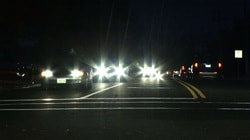
It’s that time of the year again. As Hallowe’en passes and the nights are drawing in, the drivers among us find ourselves having to drive more and more in the hours of darkness.
When carrying out an eye exam I always ask whether or not a person drives or intends to learn to drive. A common thread in this conversation is the dislike and occasional fear of driving at night. This fear has a significant impact on people’s lives as there is a large part of the year where they don’t feel safe on the road.
Research shows us that while only a quarter of car journeys are at night, more than half of all accidents occur during this time. Why should this be the case and more importantly what we can do to increase the safety of driving at night?
There are three main elements of our vision which are reduced in low light conditions – these are depth perception, colour vision and peripheral vision. Reducing one of these is bad enough but when all three are compromised then it makes sense to take precautions to enhance safety. In order to keep your vision at night time to a maximum I recommend the following.
1. Visit your optician and have your eyes tested. Only after a full, comprehensive eye exam will you we know how much your vision can be improved. If there is the potential for an improvement to100% quality then your optician will discuss this with you. Peripheral vision can also be tested at an eye exam so be sure to ask about this.
2. Wear the right glasses. Never wear tinted lenses at night - there is a false belief that tinted yellow glasses will improve night vision, this is simply not true and can actually reduce visual quality.
3. Reduce glare. Only a high quality anti-reflective lens can remove night-time glare. There are differing qualities out there but Essilor lenses such as ‘road-pilot’ remove significantly more glare than the average lens. Less glare allows for better colour perception.
4. Have good 3D vision. We only see depth when both eyes work together. Again ensure your glasses are up to date or get your eyes tested if it’s been more than two years since your last eye exam. Good depth perception allows for faster reaction times behind the wheel.
If you are concerned about your vision when driving, especially at night time then having a full eye examination is the ideal way to address these issues. At Ratoath Eyecare we carry out full, comprehensive eye examinations and use only high quality lenses in our frames.
If you have any questions regarding this blog or eye care in general, feel free to contact us on 01 689 5566 or email [email protected]
When carrying out an eye exam I always ask whether or not a person drives or intends to learn to drive. A common thread in this conversation is the dislike and occasional fear of driving at night. This fear has a significant impact on people’s lives as there is a large part of the year where they don’t feel safe on the road.
Research shows us that while only a quarter of car journeys are at night, more than half of all accidents occur during this time. Why should this be the case and more importantly what we can do to increase the safety of driving at night?
There are three main elements of our vision which are reduced in low light conditions – these are depth perception, colour vision and peripheral vision. Reducing one of these is bad enough but when all three are compromised then it makes sense to take precautions to enhance safety. In order to keep your vision at night time to a maximum I recommend the following.
1. Visit your optician and have your eyes tested. Only after a full, comprehensive eye exam will you we know how much your vision can be improved. If there is the potential for an improvement to100% quality then your optician will discuss this with you. Peripheral vision can also be tested at an eye exam so be sure to ask about this.
2. Wear the right glasses. Never wear tinted lenses at night - there is a false belief that tinted yellow glasses will improve night vision, this is simply not true and can actually reduce visual quality.
3. Reduce glare. Only a high quality anti-reflective lens can remove night-time glare. There are differing qualities out there but Essilor lenses such as ‘road-pilot’ remove significantly more glare than the average lens. Less glare allows for better colour perception.
4. Have good 3D vision. We only see depth when both eyes work together. Again ensure your glasses are up to date or get your eyes tested if it’s been more than two years since your last eye exam. Good depth perception allows for faster reaction times behind the wheel.
If you are concerned about your vision when driving, especially at night time then having a full eye examination is the ideal way to address these issues. At Ratoath Eyecare we carry out full, comprehensive eye examinations and use only high quality lenses in our frames.
If you have any questions regarding this blog or eye care in general, feel free to contact us on 01 689 5566 or email [email protected]

 RSS Feed
RSS Feed
